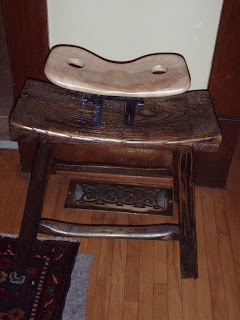If so, store bought units just wouldn't work. I needed to make my own. Not having the right parts, I bought an exercise machine and reconfigured the wheels and the trestle to do what I wanted. The rest of the parts came from a local hardware store. The most important were additional 1 1/4" grooved wheels. I found them on a patio door repair shelf. They were a match to the original machine. The wheels were the best find. You don't even need an aluminum trestle.
To begin, I believed that the center trestle should also support a passenger or two. There is some logic to this. The rear seat of a traditional boat is actually rather heavy. It may strengthen the transom, but that is not necessary. I found that I could extend the trestle as far as I needed by fitting a little oak into each end. Later on the trestle will be fastened directly to the stem and the stern probably with a few other supports The rear seat would fit over the oak. If both rower and passenger shared the same trestle, a lighter and more comfortable seat could be fabricated.
 |
| The curved seat inspired from a Chinese stool |
My first rowing unit was a sliding seat, a common design which moved forward and aft providing extra leverage with every stroke: nice, but nothing new. Along the way, I also noticed another plus. I could move the sliding seat along the trestle to trim out the boat, especially important when taking on a passenger or even a little gear. On the other hand, there is another design, a sliding rigger which is considerably more efficient. In the sliding rigger, the seat remains fixed, but the oars and the feet travel along on a second carriage on the trestle. So, I thought, why not incorporate both the sliding seat and the sliding feet into the same unit? The seat would be moved to trim out the boat, then locked in place. Then the "sliding feet" unit could do the rowing.
 |
| Side view of the rowing unit |
 | |
| Aft view: the trestle has been extended to incorporate a passenger seat |
I'm sure this idea will work. I'm not trying to win any races. I just want to row as far as I can and as long as I can without fatigue and maybe with a friend or two. Speaking of which, I had another inspiration. The sixteen gauge steel poles that form the out riggers are rather awkward when not under way. They make it difficult to pull up alongside another boat or to dock. So I mounted them in such a way as to fold inward with the release of one simple pin.
 |
| The outriggers can fold inward for transport or docking |
Last, but not least, I paid some attention to the oarlocks themselves. I chose horned oar locks, not the Douglas type. I'm more comfortable with them and find them more versatile. Mounting them took a little thought. I settled on half inch gas pipe tee couplings. Brass flanges fit nicely inside the tees and just so happened to make perfect sockets for the locks. The tees are sawed down just a little on the bottom so that the oar lock protrudes enough to stick brass plated linch pins through the little holes on the tips. The linch pins swivel 360 degrees but hold the entire assembly positively in place.
 |
| Tee couplers, oarlocks, and brass flanges |
 |
| Oarlocks, brass flanges, and linch pins |
The project was easy enough. I had to spend a little on the exercise machine. The most expensive part was getting the steel tubing bent. The local machine shop charged me a hundred and fifty: their minimum. The whole thing weighs about five pounds more, but that's not too bad, considering that it has two seats. Now to build the boat!